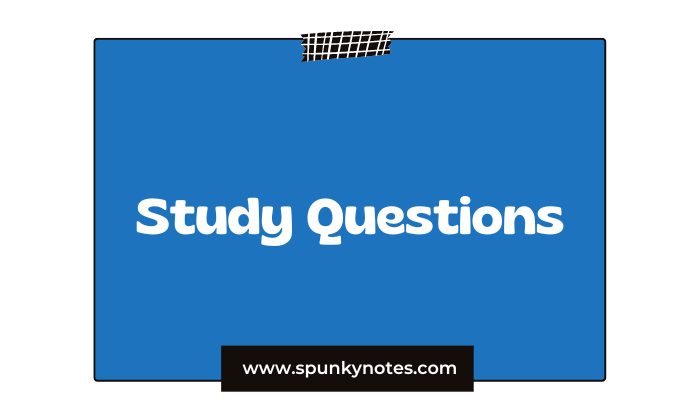
Felix Holt, the Radical MCQs
1. In what memorable year does the novel open?
A. 1829
B. 1832
C. 1800
D. 1799
2. What village was preparing a celebration for Harold Transome’s arrival?
A. Loamford
B. Treddleston
C. Little Treby
D. Stoniton
3. What physical feature best describes Mrs. Transome’s face?
A. Round cheeks
B. Eagle-like nose
C. Small mouth
D. Faint dimples
4. What was Mr. Transome doing in the library when his wife entered?
A. Reading old books
B. Sweeping leaves
C. Arranging insect specimens
D. Polishing the floor
5. What physical ailment marked Mr. Transome?
A. Heart trouble
B. A paralytic seizure
C. Deep depression
D. Severe gout
6. What job did Mrs. Transome perform for twelve years due to her husband’s feebleness?
A. Housekeeper
B. Chief bailiff
C. Seamstress
D. Secretary
7. Why was Mrs. Transome distressed about Harold’s return, even though it was longed for?
A. He had lost his fortune
B. He wanted to sell the Court
C. He felt like a stranger to her
D. He hated his father
8. What was Harold’s former professional ambition before becoming a merchant?
A. A soldier
B. A diplomatist
C. An engineer
D. A doctor
9. What news did Harold give his mother that shocked her the most?
A. He was selling the house
B. He was a wealthy merchant
C. He was marrying a Greek
D. He was a Radical
10. What did Mrs. Transome tell herself she looked like in the mirror?
A. A queen
B. A hag
C. A faded image
D. A doll
11. What was the chief source of bitterness regarding her first son, Durfey?
A. That the imbécile child should die
B. That he was a soldier
C. That he spent too much money
D. That he hated Harold
12. What was the name of Mrs. Transome’s housekeeper and lady’s maid?
A. Kitty
B. Denner
C. Lyddy
D. Esther
13. What specific affliction did Mrs. Transome fear the most in her life?
A. Being hated by her husband
B. The worst misery she could imagine
C. The worst misery she could imagine
D. Her son leaving her
14. What was the old Rector, Mr. Lingon, particularly fond of?
A. Fox hunting
B. Cock-fighting
C. Shooting
D. Drinking port
15. Who was the lawyer whom Harold was advised to use but then quietly get rid of?
A. Mr. Lingon
B. Mr. John Johnson
C. Mr. Jermyn
D. Mr. Debarry
16. What did Mr. Lingon especially dislike about the lawyer Jermyn?
A. His sleekness and white hands
B. His poor taste in jewellery
C. His excessive baldness
D. His bad clothing
17. What was Mr. Lingon’s rationale for Harold being a Radical?
A. Harold was an honest man
B. The best sort of Tory turns to the best sort of Radical
C. It was the only way to save money
D. Harold was trying to defy his father
18. What was the first business that Harold insisted on taking up after breakfast with Jermyn?
A. The condition of the poor
B. The prospects about the election
C. The estate mortgages
D. The appointment of new tenants
19. What political action did Harold say would not be his?
A. Running as a Whig
B. Getting money from London
C. Coalescing with Mr. Debarry
D. Being too honest
20. What reason did Harold give for never marrying again?
A. English wives interfere too much
B. He wanted to pursue politics
C. He lacked sufficient money
D. He preferred foreign women
21. What was Harold’s plan concerning the family lawyer, Mr. Jermyn?
A. To make him his new estate manager
B. To get rid of him quietly after the election
C. To trust him completely on the election expenses
D. To immediately file a lawsuit against him
22. What did Harold offer his mother if she stopped meddling in his politics?
A. The family silver
B. A trip to London
C. A new carriage and bays
D. Control of the stables
23. Where was the location of the great inn, the Marquis of Granby?
A. Little Treby
B. Loamford
C. Treby Magna
D. Duffield
24. What was the main trade of Mr. Tiliot, mentioned in connection with political differences?
A. Grocer
B. Lawyer
C. Spirit-merchant
D. Tape-weaver
25. What did Felix Holt inherit the occupation from his father?
A. Farming
B. A quack medicine
C. The local newspaper
D. Watchmaking
26. Where were the Dissenters in Treby Magna said to gather for worship?
A. The parish church
B. Malthouse Yard
C. The Free School
D. The Marquis of Granby
27. What did Felix say her son Felix thought of Mr. Lyon’s preaching?
A. It was too long
B. It was not high enough
C. He was a fine old fellow and an old-fashioned Puritan
D. It was too short
28. What did Felix say was the only failure a man should fear?
A. Failure to make money
B. Failure in cleaving to the right
C. Failure to convert
D. Failure to marry
29. What object in Mr. Lyon’s room did Esther disguise with green gauze?
A. A map of the Holy Land
B. A black bust
C. A portrait of Dr. Doddridge
D. A pile of books
30. What did Felix declare he would live on to keep his mother, if necessary?
A. Water
B. Bran porridge
C. Vegetables only
D. Dry bread
31. What item of Esther’s did Felix drop and expose during their first interview?
A. Her prayer book
B. Her Bible
C. Byron’s Poems
D. Her locket
32. What was the central business that brought Harold to Mr. Lyon’s house?
A. To discuss the Bible
B. To cement political adhesion
C. To ask Esther to marry him
D. To complain about Jermyn
33. What was the immediate subject on which Mr. Lyon corrected Harold’s opinion?
A. Church rates
B. The ballot-box
C. The constitution
D. The Reform Bill
34. What was the chief complaint Felix brought to Harold concerning electioneering agents?
A. They failed to canvass
B. They were dishonest to the bank
C. They bribed non-voters (colliers) with drink
D. They insulted Mr. Lyon
35. What was the first name of the last living representative of the old Transome line?
A. Henry
B. Maurice
C. Thomas
D. Matthew
36. What name did Thomas Transome, the bill-sticker, commonly go by?
A. Old Sleck
B. Tommy Trounsem
C. Dredge
D. Mike Brindle
37. What was the original basis for the Transomes’ right to the estate?
A. A royal grant
B. A base fee created in 1729
C. The death of the Bycliffe heir
D. A legal judgment in 1810
38. What condition was required for the Bycliffe claim to become valid against the Transomes?
A. If the Bycliffe heir proved the marriage
B. If the prodigal Thomas Transome’s issue became extinct
C. If the original deed was found
D. If the heir joined the Church
39. What did Mr. Tiliot accuse the Radicals of doing to lure away voters?
A. Promising them land
B. Bribing them with cheap gin
C. Stealing their votes
D. Luring away by treating done in Transome’s name
40. What sight made Felix realize his initial purpose in going to Duffield was becoming hopeless?
A. The number of police
B. The cheering crowds
C. Johnson passed to and fro and spoke to Jermyn
D. The empty hustings
41. What was the profession of the man who spoke so eloquently about monopolists to the crowd at Duffield?
A. Manufacturer
B. Trades-union man
C. Barrister
D. Labourer
42. What did Felix say was the greatest power under heaven?
A. Votes
B. Public opinion
C. The Bible
D. Money
43. Where did Felix finally manage to secure Spratt after the mob dropped him?
A. At the Seven Stars
B. At the back door of the Marquis
C. At the finger-post platform
D. In Tiliot’s vaults
44. What shocking information did Jermyn give Harold at the White Hart meeting?
A. That Harold was ruined
B. That Jermyn was his father
C. That Esther was married
D. That his mother was ill
45. What was the immediate result of the fatal encounter between Felix and Tucker?
A. Tucker was slightly injured
B. Tucker was dead from spinal concussion
C. Felix was sent home
D. Felix was immediately pardoned
46. What was Harold Transome expected to arrive at Transome Court?
A. Loamford Manor
B. The Marquis of Granby
C. Transome Court
D. Little Treby Rectory
47. What is the approximate age range of Mrs. Transome?
A. Thirties
B. Forties
C. Fifty to sixty
D. Over seventy
48. What did Mr. Transome talk loudly to when he thought he was unwatched?
A. Dominic
B. The lodge-keeper
C. His old black retriever
D. The marble statues
49. What physical ailment marked Mr. Transome’s body?
A. Heart trouble
B. A paralytic seizure
C. Deep depression
D. Severe gout
50. Who did Harold leave behind to follow him with the rest of the luggage?
A. His Greek wife
B. The business partner
C. Dominic and the small boy
D. The family lawyer
Brief Overview
Felix Holt, the Radical is a novel by George Eliot. It centers on the moral and political conflicts in a fictional English town during the 1832 Reform Act era.
The main character is Felix Holt, a poor, principled carpenter and watchmaker. Felix is a self-proclaimed Radical who strongly rejects political corruption and class privilege. He lives simply in the town of Treby Magna.
The central conflict arises when Harold Transome, a wealthy aristocrat, returns home and runs for Parliament as a Radical candidate. The election causes major unrest. Felix attempts to stop a drunken mob from rioting, but a constable is killed during the fighting. Felix is wrongly arrested for manslaughter and sent to prison.
The story also focuses on Esther Lyon, a beautiful minister’s daughter who initially finds her life dull. She comes to admire Felix’s high moral purpose. Esther discovers a major secret: she is the true, rightful heir to the vast Transome family estate.
Harold Transome, the current owner, proposes marriage to Esther. Esther visits Felix in prison and realizes she loves him more than wealth or social status. She chooses to give up her claim to the rich estate. Felix is eventually released from prison, and they marry, choosing a life dedicated to simple, honest work.

